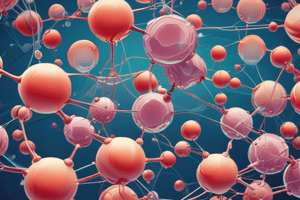Podcast
Questions and Answers
What is the precursor molecule for the synthesis of arachidonic acid?
What is the precursor molecule for the synthesis of arachidonic acid?
- Oleic acid
- Stearic acid
- Linoleic acid (correct)
- Palmitic acid
What happens to the solubility of fatty acids as the chain length increases?
What happens to the solubility of fatty acids as the chain length increases?
- It fluctuates
- It increases
- It decreases (correct)
- It remains constant
How does the melting point of fatty acids change as the number of double bonds increases?
How does the melting point of fatty acids change as the number of double bonds increases?
- It decreases (correct)
- It increases
- It remains constant
- It fluctuates
What is the configuration of double bonds in natural unsaturated fatty acids?
What is the configuration of double bonds in natural unsaturated fatty acids?
Why do unsaturated cis fatty acids have a lower melting point than saturated fatty acids?
Why do unsaturated cis fatty acids have a lower melting point than saturated fatty acids?
What is the shape of the saturated fatty acid chain?
What is the shape of the saturated fatty acid chain?
What type of interactions do saturated fatty acids have?
What type of interactions do saturated fatty acids have?
What happens to the melting point of fatty acids as the chain length decreases?
What happens to the melting point of fatty acids as the chain length decreases?
What is the effect of double bonds on the melting point of fatty acids?
What is the effect of double bonds on the melting point of fatty acids?
What is the shape of the unsaturated fatty acid chain?
What is the shape of the unsaturated fatty acid chain?
Flashcards are hidden until you start studying
Study Notes
Lipids
- Lipids are a heterogeneous group of compounds formed by mainly carbon and hydrogen atoms.
- They are insoluble in water but soluble in non-polar solvents such as ether, chloroform, and benzene.
- Lipids are important dietary constituents due to their high energy value, fat-soluble vitamins, and essential fatty acids.
Properties of Lipids
- Lipids are characterized by low solubility in water, making them relatively hydrophobic.
- They have a high energy value, making them a good source of energy.
Biological Functions of Lipids
- Storage of energy: lipids provide a lot of available energy due to their good packing and low thermal conductivity.
- Insulation from the environment: lipids provide mechanical protection, prevent excessive wetting, and prevent loss of water via evaporation.
- Membrane structure: lipids are the main structure of cell membranes.
- Cofactors for enzymes: lipids act as cofactors for enzymes, such as vitamin K and coenzyme Q.
- Signaling molecules: lipids act as signaling molecules, such as paracrine hormones, steroid hormones, growth factors, and vitamins A and D.
- Pigments: lipids are responsible for the color of certain fruits and vegetables.
- Antioxidants: lipids, such as vitamin E, act as antioxidants.
Classification of Lipids
- Lipids can be classified into three categories: simple lipids, complex lipids, and isoprene-derived lipids.
- Simple lipids include fatty acids, triglycerides, and waxes.
- Complex lipids include phospholipids, glycolipids, and lipoproteins.
- Isoprene-derived lipids include terpenes and steroids.
Fatty Acids
- Fatty acids are carboxylic acids with hydrocarbon chains containing between 4 to 36 carbons.
- Almost all natural fatty acids have an even number of carbons.
- Most natural fatty acids are unbranched.
- Fatty acids can be classified as saturated, monounsaturated, or polyunsaturated based on the number of double bonds in the chain.
Important Fatty Acids
- Palmitic acid: 16 C, saturated
- Palmitoleic acid: 16 C, a single double-bond, mono-unsaturated
- Stearic acid: 18 C, saturated
- Oleic acid: 18 C, a single double-bond, mono-unsaturated
- Linoleic acid: 18 C, two double-bond, polyunsaturated
- Linolenic acid: 18 C, three double-bond, polyunsaturated
- Arachidonic acid: 20 C, four double-bond, polyunsaturated
Essential Fatty Acids
- Essential fatty acids cannot be synthesized in the body and must be obtained through the diet.
- Linoleic acid, linolenic acid, and arachidonic acid are essential fatty acids.
Solubility and Melting Point of Fatty Acids
- Solubility of fatty acids decreases as the chain length increases.
- Melting point of fatty acids decreases as the chain length decreases and as the number of double bonds increases.
Conformation of Fatty Acids
- Saturated fatty acids tend to adopt extended conformations.
- The double bonds in natural unsaturated fatty acids are commonly in cis configuration, which kinks the chain.
Studying That Suits You
Use AI to generate personalized quizzes and flashcards to suit your learning preferences.




